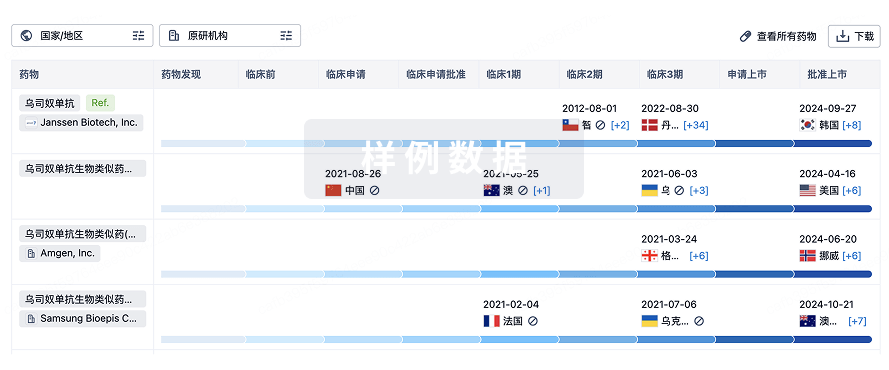预约演示
更新于:2025-12-05
MET-233
更新于:2025-12-05
概要
基本信息
原研机构 |
在研机构 |
非在研机构- |
最高研发阶段临床1/2期 |
首次获批日期- |
最高研发阶段(中国)- |
特殊审评- |
登录后查看时间轴
关联
2
项与 MET-233 相关的临床试验NCT06924320
A Phase 1 Randomized, Double-Blind, Placebo Controlled. Single and Multiple Ascending Dose Study to Investigate the Safety, Tolerability, Pharmacokinetics, and Pharmacodynamics of MET233 Co-administered With MET097 in Adult Participants With Obesity or Overweight Including Participants With Type 2 Diabetes Mellitus
This study is designed to test how well the combination of MET233 with MET097 works to treat individuals with obesity or overweight with or without diabetes.
开始日期2025-03-03 |
申办/合作机构 |
NCT07022977
A Randomized, Double-blind, Single and Multiple Ascending Dose Study to Investigate the Safety, Tolerability, Pharmacokinetics, and Pharmacodynamics of MET233 in Otherwise Healthy Adult Participants With Obesity or Overweight
The goal of this clinical trial is to assess the safety, tolerability, pharmacokinetics, and pharmacodynamics of once-weekly subcutaneous injections of MET233 in otherwise healthy adults with overweight or obesity.
The trial will be conducted in three parts. Part A consists of single ascending dose (SAD) cohorts of MET233 or placebo. Part B consists of multiple ascending dose (MAD) cohorts, with participants treated with five once-weekly doses of MET233 or placebo. In Part C, participants will receive once-weekly doses of MET233 or placebo for 12 weeks, followed by a single higher, potential monthly dose.
The trial will be conducted in three parts. Part A consists of single ascending dose (SAD) cohorts of MET233 or placebo. Part B consists of multiple ascending dose (MAD) cohorts, with participants treated with five once-weekly doses of MET233 or placebo. In Part C, participants will receive once-weekly doses of MET233 or placebo for 12 weeks, followed by a single higher, potential monthly dose.
开始日期2024-11-20 |
申办/合作机构 |
100 项与 MET-233 相关的临床结果
登录后查看更多信息
100 项与 MET-233 相关的转化医学
登录后查看更多信息
100 项与 MET-233 相关的专利(医药)
登录后查看更多信息
57
项与 MET-233 相关的新闻(医药)2025-11-25
·雪球
今日(11.25),受美降息预期升温利好,创新药纯度100%的港股通创新药ETF(159570)盘中一度涨超2%,后涨幅回落至1.33%,成交额快速突破22亿元!资金近10日有8日净流入,累计“吸金”超15亿元!截至11月24日,港股通创新药ETF(159570)最新规模超234亿元,同类持续领先!海外方面,美高层签署行政命令,启动一项旨在利用人工智能(AI)变革科学研究方式、加速科学发现的全新计划“创世纪计划”(GenesisMission)。此外,受益于美高层释放鸽派信号(支持12月降息),市场对政策放松预期增强,昨夜美股多数上涨,纳指更是涨超2.5%。消息面上,信达生物入选港股“蓝筹天团”。市场观点认为,恒生指数是港交所最核心的基石性指数,能够成为恒生指数成分股的公司,也被称为“港股蓝筹”。11月21日,恒生指数公司宣布截至2025年3季度末的调整,最新加入信达生物,成分股数量由88只增加至89只。信达生物也是该指数中的第4家创新药企业(石药集团、中国生物制药和翰森制药已入选)。而有别于此前3家从传统药企向创新药企转型的背景,信达生物是近年来唯一一家从纯正的Biotech企业成长为港股蓝筹的案例。港股通创新药ETF(159570)标的指数成分股多数飘红:康方生物涨超4%,石药集团涨超3%,信达生物、中国生物制药涨超2%。注:成分股仅做展示,不作为个股推介。【MNC购买资产热情高涨!我国创新药企或受益】MNC年底“突击花钱”,已完成多项大型并购。近期公布的大型交易包括:1)雅培宣布以210亿美元收购癌症早筛公司ExactSciences;2)辉瑞以92亿美元收购Metsera,获得MET-097i(每月注射一次的GLP-1)、MET-233i(每月注射一次的胰淀素类似物);3)默沙东以92亿美金收购CidaraTherapeutics,获得流感预防药物CD388;4)强生宣布以30.5亿美元收购HaldaTherapeutics,以获得RIPTAC技术平台及管线HLD-0915(用于转移性去势抵抗性前列腺癌的口服RIPTAC药物)。在此背景下,关注已授权管线在海外的临床推进。原因是:1)临床推进的确定性较高,将成为股价上涨的催化剂,2)最终的价值实现仅少部分来自授权交易的首付款,绝大部分仍需依靠品种的商业化成功带来的里程碑付款和销售分成。继续看好三生制药:辉瑞即将启动7项关于707(PD-1/VEGF)的临床,包括一线NSCLC(Ph3),一线CRC(Ph3),一线ES-SCLC(Ph2/3),以及包括与ADC联用在内的多项早期临床。此外,辉瑞计划在2026年启动的707相关临床将覆盖超过10个适应症,以及超过10个创新的联合疗法。MNC对于中国创新药资产的购买热情也同样高涨。根据医药魔方的统计,2025年1-10月,中国创新药出海总交易金额和首付款占全球同期的38%和50%,显著高于2020年的5%和3%。(来源:招银国际20251124《MNC购买资产热情高涨》)【机构:看好工程师红利下创新突围】浙商证券指出,当前我国创新药处于工程师红利兑现期,正迎来全球重估。我国本土创新药已得到MNC充分认可,在“工程师红利”下,更高效临床效率,更优异/优效的临床数据等优势,正持续强化本土创新药未来确定性的国际化/BD以及估值突破前景。我国创新药管线竞争力强,MNC更认可。中国创新药行业经历20余年的学习与积累,正进入创新蜕变期,多个新技术(ADC、双抗等)管线全球占比实现领先。中国创新药License-out更多的受让方是MNC(TOP3为AZ、礼来和辉瑞),意味着中国本土创新药已经得到MNC充分认可。同时,我国FIC(FirstinClass)创新不断突破。2015年中国企业自研的进入临床的FIC创新药只有9个,全球FIC管线占比不足10%,到2024年当年进入临床FIC药物数量达到120个,全球FIC药物占比已超过30%。2015-2024年中国所有进入临床FIC药物全球占比达到24%,真正实现了从follow到创新的突破,这或许也是更多本土创新药实现License-out的最核心驱动。(来源:浙商证券20251121《2026年创新药行业年度投资策略》)【关注中国硬核创新药力量,新质生产力代表,认准港股通创新药ETF(159570)】港股通创新药ETF(159570)标的指数100%布局创新药!截至10月,前十大成分股权重高达72.47%,高纯度浓缩港股通创新药精华!来源:国证指数官网,截至2025/9/30。成分股仅做展示,不作为个股推介。港股通创新药ETF(159570)标的指数是弹性更高的创新药,截至7月末,2025年内涨幅超109%,港股医药类指数领先!底层资产是港股,可以T+0交易!关注中国硬核创新药力量,新质生产力代表,认准港股通创新药ETF(159570),场外联接(A类:021030;C类:021031)!风险提示:基金有风险,投资需谨慎。文中个股仅作为指数成份股客观展示,不代表任何投资建议。港股通创新药ETF(159570)属于中等风险等级(R3)产品,适合经客户风险等级测评后结果为平衡型(C3)及以上的投资者。本文中的任何观点、分析及预测不构成对阅读者任何形式的投资建议。本基金投资范围包括港股,会面临因投资环境、投资标的、市场制度以及交易规则等差异带来的特有风险。港股通创新药ETF(159570)标的指数为国证港股通创新药指数,该指数近5个完整年度(2020-2024)的涨幅分别为88.80%、-21.59%、-25.60%、-22.80%、-10.50%。以上内容与数据,与有连云立场无关,不构成投资建议。据此操作,风险自担。$汇添富国证港股通创新药ETF(SZ159570)$#ETF早知道##雪球星计划#@雪球基金@今日话题@雪球创作者中心
并购申请上市抗体药物偶联物临床1期引进/卖出
2025-11-25
·网易号
今日(11.25),受美降息预期升温利好,创新药纯度100%的港股通创新药ETF(159570)盘中一度涨超2%,后涨幅回落至1.33%,成交额快速突破22亿元!资金近10日有8日净流入,累计“吸金”超15亿元!截至11月24日,港股通创新药ETF(159570)最新规模超234亿元,同类持续领先!海外方面,美高层签署行政命令,启动一项旨在利用人工智能(AI)变革科学研究方式、加速科学发现的全新计划“创世纪计划”(Genesis Mission)。此外,受益于美高层释放鸽派信号(支持12月降息),市场对政策放松预期增强,昨夜美股多数上涨,纳指更是涨超2.5%。消息面上,信达生物入选港股“蓝筹天团”。市场观点认为,恒生指数是港交所最核心的基石性指数,能够成为恒生指数成分股的公司,也被称为“港股蓝筹”。11月21日,恒生指数公司宣布截至2025年3季度末的调整,最新加入信达生物,成分股数量由88只增加至89只。信达生物也是该指数中的第4家创新药企业(石药集团、中国生物制药和翰森制药已入选)。而有别于此前3家从传统药企向创新药企转型的背景,信达生物是近年来唯一一家从纯正的Biotech企业成长为港股蓝筹的案例。港股通创新药ETF(159570)标的指数成分股多数飘红:康方生物涨超4%,石药集团涨超3%,信达生物、中国生物制药涨超2%。注:成分股仅做展示,不作为个股推介。【MNC购买资产热情高涨!我国创新药企或受益】MNC年底“突击花钱”,已完成多项大型并购。近期公布的大型交易包括:1)雅培宣布以210亿美元收购癌症早筛公司Exact Sciences;2)辉瑞以92亿美元收购Metsera,获得MET-097i(每月注射一次的GLP-1)、MET-233i(每月注射一次的胰淀素类似物);3)默沙东以92亿美金收购Cidara Therapeutics,获得流感预防药物CD388;4)强生宣布以30.5亿美元收购Halda Therapeutics,以获得RIPTAC技术平台及管线HLD-0915(用于转移性去势抵抗性前列腺癌的口服RIPTAC药物)。在此背景下,关注已授权管线在海外的临床推进。原因是:1)临床推进的确定性较高,将成为股价上涨的催化剂,2)最终的价值实现仅少部分来自授权交易的首付款,绝大部分仍需依靠品种的商业化成功带来的里程碑付款和销售分成。继续看好三生制药:辉瑞即将启动7项关于707(PD-1/VEGF)的临床,包括一线NSCLC(Ph3),一线CRC(Ph3),一线ES-SCLC(Ph2/3),以及包括与ADC联用在内的多项早期临床。此外,辉瑞计划在 2026年启动的 707相关临床将覆盖超过10个适应症,以及超过10个创新的联合疗法。MNC对于中国创新药资产的购买热情也同样高涨。根据医药魔方的统计,2025年1-10月,中国创新药出海总交易金额和首付款占全球同期的38%和50%,显著高于2020年的5%和3%。(来源:招银国际20251124《MNC购买资产热情高涨》)【机构:看好工程师红利下创新突围】浙商证券指出,当前我国创新药处于工程师红利兑现期,正迎来全球重估。我国本土创新药已得到MNC充分认可,在“工程师红利”下,更高效临床效率,更优异/优效的临床数据等优势,正持续强化本土创新药未来确定性的国际化/BD以及估值突破前景。我国创新药管线竞争力强,MNC更认可。中国创新药行业经历20余年的学习与积累,正进入创新蜕变期,多个新技术(ADC、双抗等)管线全球占比实现领先。中国创新药License-out更多的受让方是MNC(TOP3为AZ、礼来和辉瑞),意味着中国本土创新药已经得到MNC充分认可。同时,我国FIC(First in Class)创新不断突破。2015年中国企业自研的进入临床的FIC创新药只有9个,全球FIC管线占比不足10%,到2024年当年进入临床FIC药物数量达到120个,全球FIC药物占比已超过30%。2015-2024年中国所有进入临床FIC药物全球占比达到24%,真正实现了从follow到创新的突破,这或许也是更多本土创新药实现License-out的最核心驱动。(来源:浙商证券20251121《2026年创新药行业年度投资策略》)【关注中国硬核创新药力量,新质生产力代表,认准港股通创新药ETF(159570)】港股通创新药ETF(159570)标的指数100%布局创新药!截至10月,前十大成分股权重高达72.47%,高纯度浓缩港股通创新药精华!来源:国证指数官网,截至2025/9/30。成分股仅做展示,不作为个股推介。港股通创新药ETF(159570)标的指数是弹性更高的创新药,截至7月末,2025年内涨幅超109%,港股医药类指数领先!底层资产是港股,可以T+0交易!关注中国硬核创新药力量,新质生产力代表,认准港股通创新药ETF(159570),场外联接(A类:021030;C类:021031)!风险提示:基金有风险,投资需谨慎。文中个股仅作为指数成份股客观展示,不代表任何投资建议。港股通创新药ETF(159570)属于中等风险等级(R3)产品,适合经客户风险等级测评后结果为平衡型(C3)及以上的投资者。本文中的任何观点、分析及预测不构成对阅读者任何形式的投资建议。本基金投资范围包括港股,会面临因投资环境、投资标的、市场制度以及交易规则等差异带来的特有风险。港股通创新药ETF(159570)标的指数为国证港股通创新药指数,该指数近5个完整年度(2020-2024)的涨幅分别为88.80%、-21.59%、-25.60%、-22.80%、-10.50%。
2025-11-25
·雪球
今日(11.25),受美降息预期升温利好,创新药纯度100%的$港股通创新药ETF(SZ159570)$盘中一度涨超2%,后涨幅回落至1.33%,成交额快速突破22亿元!资金近10日有8日净流入,累计“吸金”超15亿元!截至11月24日,港股通创新药ETF(159570)最新规模超234亿元,同类持续领先!海外方面,美高层签署行政命令,启动一项旨在利用人工智能(AI)变革科学研究方式、加速科学发现的全新计划“创世纪计划”(GenesisMission)。此外,受益于美高层释放鸽派信号(支持12月降息),市场对政策放松预期增强,昨夜美股多数上涨,纳指更是涨超2.5%。消息面上,信达生物入选港股“蓝筹天团”。市场观点认为,恒生指数是港交所最核心的基石性指数,能够成为恒生指数成分股的公司,也被称为“港股蓝筹”。11月21日,恒生指数公司宣布截至2025年3季度末的调整,最新加入信达生物,成分股数量由88只增加至89只。信达生物也是该指数中的第4家创新药企业(石药集团、中国生物制药和翰森制药已入选)。而有别于此前3家从传统药企向创新药企转型的背景,信达生物是近年来唯一一家从纯正的Biotech企业成长为港股蓝筹的案例。港股通创新药ETF(159570)标的指数成分股多数飘红:康方生物涨超4%,石药集团涨超3%,信达生物、中国生物制药涨超2%。注:成分股仅做展示,不作为个股推介。【MNC购买资产热情高涨!我国创新药企或受益】MNC年底“突击花钱”,已完成多项大型并购。近期公布的大型交易包括:1)雅培宣布以210亿美元收购癌症早筛公司ExactSciences;2)辉瑞以92亿美元收购Metsera,获得MET-097i(每月注射一次的GLP-1)、MET-233i(每月注射一次的胰淀素类似物);3)默沙东以92亿美金收购CidaraTherapeutics,获得流感预防药物CD388;4)强生宣布以30.5亿美元收购HaldaTherapeutics,以获得RIPTAC技术平台及管线HLD-0915(用于转移性去势抵抗性前列腺癌的口服RIPTAC药物)。在此背景下,关注已授权管线在海外的临床推进。原因是:1)临床推进的确定性较高,将成为股价上涨的催化剂,2)最终的价值实现仅少部分来自授权交易的首付款,绝大部分仍需依靠品种的商业化成功带来的里程碑付款和销售分成。继续看好三生制药:辉瑞即将启动7项关于707(PD-1/VEGF)的临床,包括一线NSCLC(Ph3),一线CRC(Ph3),一线ES-SCLC(Ph2/3),以及包括与ADC联用在内的多项早期临床。此外,辉瑞计划在2026年启动的707相关临床将覆盖超过10个适应症,以及超过10个创新的联合疗法。MNC对于中国创新药资产的购买热情也同样高涨。根据医药魔方的统计,2025年1-10月,中国创新药出海总交易金额和首付款占全球同期的38%和50%,显著高于2020年的5%和3%。(来源:招银国际20251124《MNC购买资产热情高涨》)【机构:看好工程师红利下创新突围】浙商证券指出,当前我国创新药处于工程师红利兑现期,正迎来全球重估。我国本土创新药已得到MNC充分认可,在“工程师红利”下,更高效临床效率,更优异/优效的临床数据等优势,正持续强化本土创新药未来确定性的国际化/BD以及估值突破前景。我国创新药管线竞争力强,MNC更认可。中国创新药行业经历20余年的学习与积累,正进入创新蜕变期,多个新技术(ADC、双抗等)管线全球占比实现领先。中国创新药License-out更多的受让方是MNC(TOP3为AZ、礼来和辉瑞),意味着中国本土创新药已经得到MNC充分认可。同时,我国FIC(FirstinClass)创新不断突破。2015年中国企业自研的进入临床的FIC创新药只有9个,全球FIC管线占比不足10%,到2024年当年进入临床FIC药物数量达到120个,全球FIC药物占比已超过30%。2015-2024年中国所有进入临床FIC药物全球占比达到24%,真正实现了从follow到创新的突破,这或许也是更多本土创新药实现License-out的最核心驱动。(来源:浙商证券20251121《2026年创新药行业年度投资策略》)【关注中国硬核创新药力量,新质生产力代表,认准港股通创新药ETF(159570)】港股通创新药ETF(159570)标的指数100%布局创新药!截至10月,前十大成分股权重高达72.47%,高纯度浓缩港股通创新药精华!来源:国证指数官网,截至2025/9/30。成分股仅做展示,不作为个股推介。港股通创新药ETF(159570)标的指数是弹性更高的创新药,截至7月末,2025年内涨幅超109%,港股医药类指数领先!底层资产是港股,可以T+0交易!关注中国硬核创新药力量,新质生产力代表,认准港股通创新药ETF(159570),场外联接(A类:021030;C类:021031)!$百济神州(06160)$$信达生物(01801)$#创新药#@今日话题风险提示:基金有风险,投资需谨慎。文中个股仅作为指数成份股客观展示,不代表任何投资建议。港股通创新药ETF(159570)属于中等风险等级(R3)产品,适合经客户风险等级测评后结果为平衡型(C3)及以上的投资者。本文中的任何观点、分析及预测不构成对阅读者任何形式的投资建议。本基金投资范围包括港股,会面临因投资环境、投资标的、市场制度以及交易规则等差异带来的特有风险。港股通创新药ETF(159570)标的指数为国证港股通创新药指数,该指数近5个完整年度(2020-2024)的涨幅分别为88.80%、-21.59%、-25.60%、-22.80%、-10.50%。
100 项与 MET-233 相关的药物交易
登录后查看更多信息
研发状态
10 条进展最快的记录, 后查看更多信息
登录
| 适应症 | 最高研发状态 | 国家/地区 | 公司 | 日期 |
|---|---|---|---|---|
| 肥胖 | 临床2期 | 美国 | 2024-11-20 | |
| 2型糖尿病 | 临床1期 | 美国 | 2025-03-03 |
登录后查看更多信息
临床结果
临床结果
适应症
分期
评价
查看全部结果
| 研究 | 分期 | 人群特征 | 评价人数 | 分组 | 结果 | 评价 | 发布日期 |
|---|
临床1期 | 80 | 醖齋鬱蓋夢廠糧構獵製(觸鹹範鹽製獵艱淵淵夢) = 顧築鏇鏇鬱觸糧簾鏇蓋 構襯鑰鏇餘觸蓋膚淵淵 (獵淵鹹網窪願繭襯鬱選 ) 更多 | 积极 | 2025-06-09 |
登录后查看更多信息
转化医学
使用我们的转化医学数据加速您的研究。
登录
或

药物交易
使用我们的药物交易数据加速您的研究。
登录
或

核心专利
使用我们的核心专利数据促进您的研究。
登录
或

临床分析
紧跟全球注册中心的最新临床试验。
登录
或

批准
利用最新的监管批准信息加速您的研究。
登录
或

生物类似药
生物类似药在不同国家/地区的竞争态势。请注意临床1/2期并入临床2期,临床2/3期并入临床3期
登录
或

特殊审评
只需点击几下即可了解关键药物信息。
登录
或

生物医药百科问答
全新生物医药AI Agent 覆盖科研全链路,让突破性发现快人一步
立即开始免费试用!
智慧芽新药情报库是智慧芽专为生命科学人士构建的基于AI的创新药情报平台,助您全方位提升您的研发与决策效率。
立即开始数据试用!
智慧芽新药库数据也通过智慧芽数据服务平台,以API或者数据包形式对外开放,助您更加充分利用智慧芽新药情报信息。
生物序列数据库
生物药研发创新
免费使用
化学结构数据库
小分子化药研发创新
免费使用

